|
Part 1 - carving /
Part 2 - Analysis of the weak points
/
Part 3 - Preparation of the components
|
My first 2CV - the way it started
|
The TÜV of my Fiat Tipo was due in a half year and the necessary investments for the acquisition of this quality seal would not be insignificant. All tires (including spare wheel) were nearly profileless and three of the tires had been patched already (195mm tires can pick up lots of screws and nails), the sound of the engine increased day by day because of a burst 'flame tube' (it did not know at all that my little Italian had something like that) and finally the rust at the undercarriage couldn't be ignored by the technical inspectors (nevertheless it was the first Fiat series galvanized at this area). I could ignore little things like defective ABS sensors and really unhandsome rims (nevertheless from aluminum) since I had bought the car 4 years ago. The normal repair would exceed the current value clearly.
Something new (old) had to be pruchased. In the last years I postulated only two things of the vehicle to be acquired: On the one hand the TÜV sticker at the registration plate should last for the next 2 years and on the other hand the purchase price should be below 1000, - Eus. No one of my relatives had a car to offer (my oldest brother kept his vehicles always maintained by a garage even if they became very old). We have modern times, so I booted my computers had a look at the world wide web. When studying the offers I stumbled over a Volkswagen beetle. This vehicle hurt condition 1, because it was nearly without TÜV, but my original intention suddenly changed. I was always fascinated by oldtimers, but never seriously planned to buy one. I am no motor mechanic and didn't want to spend all of my time with searching for spare parts at oldtimer markets. But there were millions of beetles produced and according to the legend the technology of the cars was terribly simple. Let's see what's told about the car at the Internet. Spare part dealers were constituted fast and cars at reasonable prices were to be found also and if I am already online, let's have a closer look at the French variant of the 'beetle'. After a long night the decision fell in favor of the duck. On the one hand to me as a amateur in the topic of car technology, the 2CV seemed to be more more simple than the beetle (e.g. only half as much cylinders) and on the other hand I read more funny stories about ducks:)
The following days I watched out for a suitable object and found one in Darmstadt. The fact that the framework was rusted through and had to be exchanged and that the rust gnaws at the little house could be seen clearly. The engine started immediately, worked audibly (between front and rear silencer wasn't a continuous connection), but perfectly and brought the 2 CV up to speed with the help of the well switching transmission. Marking the district with some oil drops, was a attribute which several of my previous vehicles possessed. It took 900,- Euros to make it mine, so at least condition number two was fulfilled. 3 months of TÜV should be sufficient to do the framework exchange (there are only a few screws to be loosened).
Of good cheer, but with low speed (the 113 horses of my Fiat were somewhat more powerful) I drove home in stormy rainy weather. The previous owner let me pass with his homologation and so I had the pleasure to drive a 2CV for the first time approx. 80km long with steadily more largely becoming trucks in the rear mirror.
|
28. März 2004
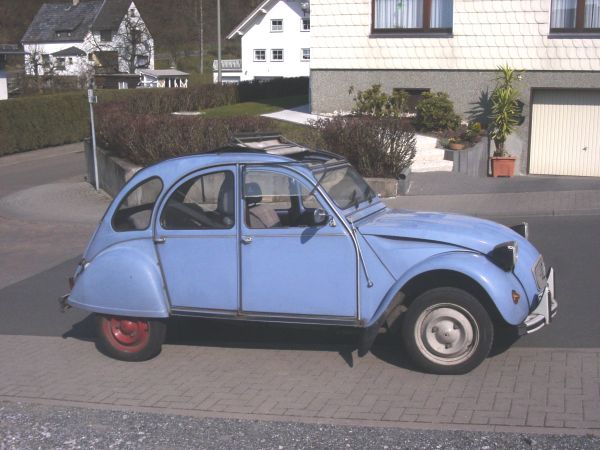
My new acquisition landed.
|
Call for a wrench - the disassembly
|
At the following weekend I started the project. Hood, trunk lids and the rear doors are fastly shifted out. The hinge-joints of the front doors loosened and passenger seat and backseats taken out. Now driving out of the garage by own engine power for the last time and shooting some photos. I could have unmounted the front fenders also, but somehow I thought these construction units had a static function. Meanwhile I know better.
Next I took a gasoline can in order to transfer the valuable juice to my Fiat. When I went towards the duck with the can in my hand, my neighbour Klaus past by and said: 'You're right, set this thing to fire.' I was too astonished to give an answer before he disappeared in his house. The whole thing wasn't really seriously meant and Klaus supported me in the following with my restoration efforts.
|
3. April 2004
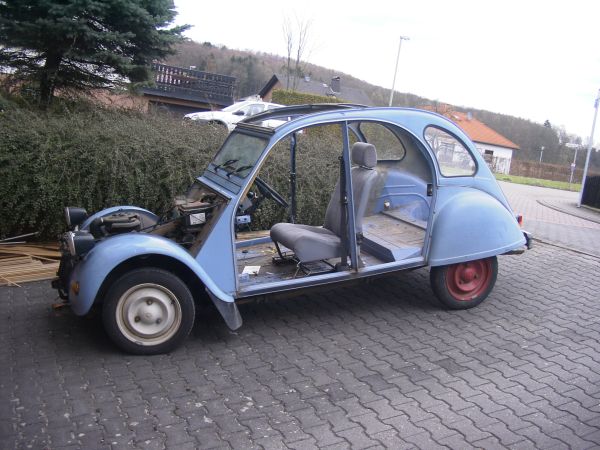
Last drivingefficient condition.
|
|
In front of the garage I digged the waste out of the car. My new acquisition wasn't really check book and washroad maintained over the past months. Probably a squirrel had its winter accomodation here at last, I can't explain the existence of so many hazlenuts in every corner of the body somehow else.
|
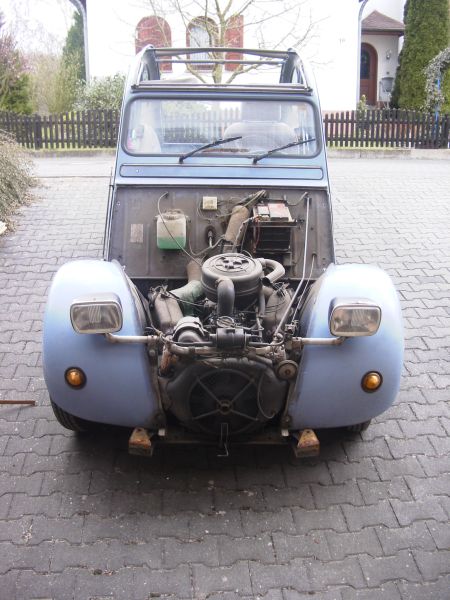
Last drivingefficient condition.
|
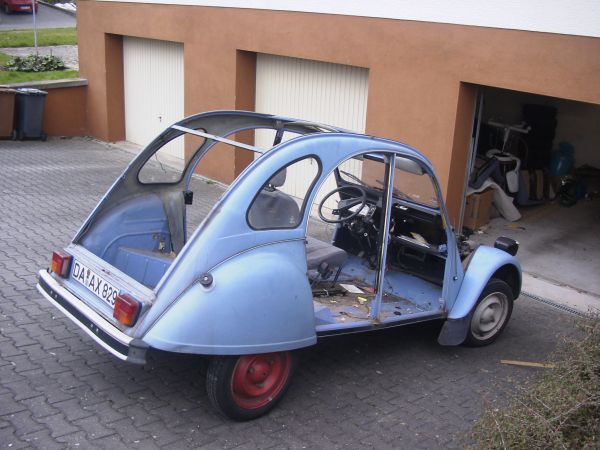
Last drivingefficient condition.
|
So far so simple - the screws of the body attachment offered partially embittered resistance then, so some of them lost their heads. Rust remover and soldering lamp should be allways readily to hand. The last tool should not be used near bearings and seals, since they do not withstand the heat. Otherwise you can force rusted screw to rotation again, particularly within the exhaust pipes. The last tool to use is the angle grinder - when assembling the car you should use stainless steel screws and nuts anyway. It's also very advisable to loosen the screws always anticlockwise (I sometimes confounded that...).
The most usual screw size with the 2CV is M7 in different lengths to process with a 11mm wrench. Stupidly you can't by those screws in every do-it-yourself store. Apropos do-it-yourself store - with the tool, chaff and wheat separate fast when loosening rusty screws. Good tools are to be prefered to the sale of the century. Here thanks at Ferdi, who supported me from time to time with his 'man tools'.
If all screws of the body attachment are loosened, the body sticks usually still quite firm at the framework. The foam rubber tape between these construction units, which prevents the friction and thus the rust accumulation, is responsible for this. Here you need pure muscle power.
|
24. April 2004
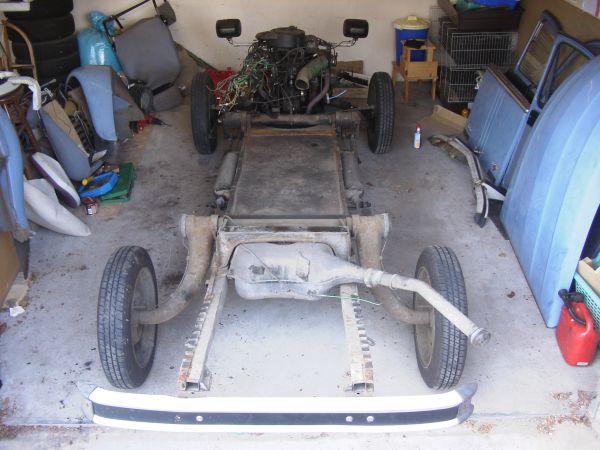
|
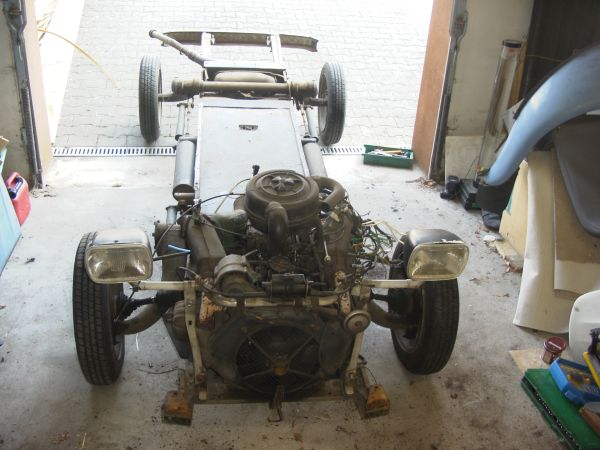
|
|
Sometimes I had to study the 2CV-Forum, in order to separate some parts, but it preceded briskly at all. I explained the disassembly of the critical parts more exactly at the column 'assembly'.
|

Meanwhile one garage is not large enough any longer...
|
|
Forward to part 2 - Analysis of the weak points
|